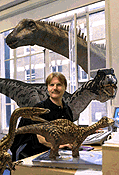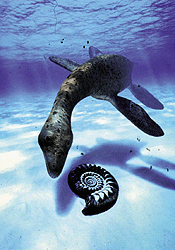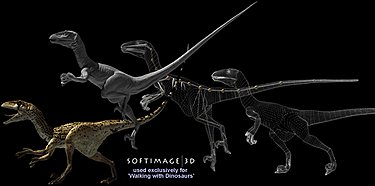Eric Huelsman predicts that Walking With Dinosaurs will be hailed as one of the most scientifically significant technological benchmarks in broadcast television for many years to come. Here's why...
In my view, it is the most awesome science program ever produced. Nothing before ever made for television even approaches it, so breathtaking is its scope, its thoroughness and its authenticity. It is an incredible three-hour journey into prehistory that, while as provocative as any fictional account of dinosaurs that has ever been made, is, more importantly, a wildlife documentary that stands on its own as an unprecedented achievement for natural history. The "it" I'm referring to is the BBC/Discovery Channel mini-series Walking With Dinosaurs; which, by all measures of television entertainment will, like what Jurassic Park did for motion pictures, be hailed as one of the most scientifically significant technological benchmarks in broadcast television for many years to come.

Comparisons to Jurassic Park are sadly inevitable but, as such, I am happy to report that Walking With Dinosaurs is simply stunning -- almost unbelievable -- even for the most jaded dinosaur fans out there. The computer generated animation wrought for these creatures, handled by the British firm FrameStore, is so astonishingly true to life that paleontologists hired to facilitate the making of the show ended up writing new chapters for "the book" on dinosaurs as a result. And it is, by all accounts, the first time ever that a production of this magnitude has tried so diligently to recreate the natural ecosystems in which dinosaurs lived, e.g. how they hunted, bore offspring, etc. So much so that the experience of watching Walking With Dinosaurs is veritably no different than what one would expect from watching say, a wildlife documentary about hippos or lions in Africa; except that these animals lived over 65 millions years ago! In fact, Walking With Dinosaurs has been heralded by some scientists as being the most credibly accurate depiction of dinosaur life ever produced, theatrical, TV or otherwise. And, if this is any indication of the excellence of the production crew that put the show together, it was all done on a production budget of less than $10 million. So, if you're asking, how on Pangaea did they do it, Virginia? Read on. And stop calling me Virginia.

Big Thunder (Lizards) on a Small Budget In Hollywood, the litmus test of a successful dinosaur show is how much box office the dinos can generate. Jurassic Park, for example, made into the many hundreds of millions of dollars on receipts for both that picture and its sequel, Jurassic Park 2. Yet only 7 to 8 minutes of the first picture and 10 minutes of the sequel showed any dinosaurs at all, despite the motion pictures' relatively large budgets. So why not more dinos? Too expensive to make, as the BBC would come to find out.
When first approached in 1995 to do the job, the CG dinosaur factory of Industrial Light & Magic, which had done the dinos for both Jurassic Park movies, quoted the BBC a whopping $10,000 per second to do the CG. At $10,000 a second for two and a half hours, you do the math. Not many producers at BBC could justify a tenth of that kind of expense, so imagine the dilemma facing Tim Haines, BBC Science Producer in charge of making Walking With Dinosaurs. Considering the show's total running time of 180 minutes, 150 minutes of it CG, what was one to do?
As a zoologist with a background in paleontology, Haines was keenly aware that it would take far more than three hours of TV to depict the entire history of dinosaurs. Many thousands of species of dinosaur thrived throughout the Triassic, Jurassic and Cretaceous Periods. Thus, settling on a representative smattering of the more interesting species, such as the mammoth sea monster Lilopleurodon or the giant pterosaur Omithocheirus, as well as the obligatory Tyrannosarus Rex and Diplodicus, was really going to need to strike a careful balance between that which would hold the interest of science-savvy viewers as well as making for exciting television for the dinosaurs' more er...bloodthirsty fans.

Mike Milne and FrameStore
Returning to England empty-handed (and still left with two and a half hours of CG to account for), Haines and company decided to contact a local production company with impeccable credentials to do their dinosaurs. Enter Mike Milne and the London-based special effects company, FrameStore. Mike and his crew had already won Emmys for their effects in the prime-time productions of Alice In Wonderland, Merlin, The Odyssey and Gulliver's Travels. Undaunted by the task of producing two and a half hours of CG dinosaurs, Milne and his crew of 15 designers decided to take on an apparently kamikaze task with staid British aplomb.
Such as it was, Milne and FrameStore started out with 24 dinosaurs to make (but, per the needs of the entire run of six BBC episodes, ended up with 40 by the end of the production). However, since it was a natural history-type of series, it was FrameStore's job to not only create these creatures, but to synthesize the entire environment these dinosaurs lived in given a very limited amount of information. As it turns out, recreating the ecosystems themselves involved some pretty exotic location shooting and some photographic sleight-of-hand (to be described later).
Making the Models
To begin with, paleontologists were contracted by the BBC to assist FrameStore in the production so that the most up-to-date data on how dinosaurs were constructed could be used to make the creatures look as life-like as possible. Using this data from the science team, FrameStore's sculptors produced highly detailed scale models of each of the dinosaurs. These models, which are referred to in the CG industry as maquettes, were first sculpted in clay. Then a resin cast was made of these maquettes and these casts were, in turn, covered with an optically opaque paint for digitizing. FrameStore used a high-res laser scanner for this task and, along with partner Soho-CyberScan, developed a set of proprietary software tools to capture as much of the 3D form and texture detail as possible.
Scanned data from the maquettes was initially imported into Softimage as a very large point cloud of over 6 million three-dimensional reference points, which was later reduced about 85% to produce a more computationally-digestible polygonal mesh consisting of about one million points. A low-res version of the maquette was then made for animation purposes, thus enabling the animators to see creature movement playback in real-time. A stick and ball skeleton was then made, thus enabling the animators to isolate different parts of the dinosaur for manipulation.
Once the high and low-res polygonal models had been made, the correct scale and orientation for each dinosaur had to be set, so as to match the camera and scene data for each shot. This was a critical part of how FrameStore saved expense as almost all of the background and many foreground shots were practicals, shot on location in New Zealand and other exotic tropical locales where flora, like ferns, resemble those of the prehistoric periods depicted in the show.

Skinning a Dino
Since no one will likely ever know what dinosaur skin looked like, textures and colors for the CG dinosaur skin was derived through a best scientific guess process of understanding the animals' habitats, their lifestyle, whether they were carnivores or herbivores, and body size as larger animals tend to have duller skin colors. But Daren Horley, responsible for designing the dinosaurs' skin, despite being fortunate enough to have a sample of an impression of actual dinosaur skin sent to him, nonetheless found himself having to compromise on a few things. "I discovered that to make the scale texture [of dinosaur skin] show up on television, I had to make [the scales] reasonably large," he says. "It became an informed compromise between what was scientifically accurate and what looked right on-screen."
Once the BBC producers had approved the designs for the skin colors a bump map was made. A bump map is a black and white 2D image that the software will see as bumps or surface irregularities for shadow and highlight detail. A color map was then painted over the bump map and the resultant skin image wrapped around the 3D model, very much like a tight-fitting suit.

How Do You Move a 70 Ton Dino? By Hand, Naturally!
A very interesting fact that has emerged from how the FrameStore's relatively small staff made 40 dinosaurs come to life was that animal movements were largely the result of hand animation, an extremely laborious and time-consuming process. But for this kind of show Mike Milne and his animators saw early on that hand animation (moves made manually on the computer as opposed to allowing the computer to keyframe, or do the calculation automatically), was going to have to be the way to go. "The only way we could achieve convincing animation, the little wobbles here and there and the way the underlying structures of the skin change with movement, was to animate the dinos by hand," says Milne.
Since many of the backgrounds and foregrounds were already filmed (along with the movements of trees, splashing of water and other actual footage), FrameStore's animators had to be doubly attentive to shot details. To again simplify the animation process, the animators used low-res models with stick and ball skeletons in much the way puppeteers manipulate a puppet's body parts to make them move. This created extremely convincing animation, as the animators were able to control the dinosaurs' movements 100% of the time, a single frame at a time, thus maximizing their naturalness when composited with the live-action footage. The Real Deal But were the dinos' movements going to be convincing enough? Since no one actually knew how a T-Rex's forelimbs would move, how would the animators make it look natural on-screen? True to the remarkable attention to details given this production, a decision was made early on to use, among other things, live elephants to "model" dinosaur movement for the animators to study and use.
Inferring what they already knew from their own experience as character animators, as well as consulting paleontologists as to the actual dynamics of the gigantic joints, tendons and muscles of dinosaurs, the FrameStore team was now able to use more than just an educated guess to fancy precisely how these gigantic animals would movethey could apply the dynamics to T-Rex's forelimbs in a way never before seen in motion graphic depictions of their movements.

For example, given what paleontologists knew about the winged giant Ornithocheirus, the crew itself made the educated assumption that such a beast would walk much like a man on crutches. The effect is striking, but probable, given what scientists know about body structures. Such attention to detail has its payoffs as the resultant animation -- every snort, eye blink and umgaseous emission -- is deftly handled throughout the show.
CG Versus Animatronics
Despite what might seem a need to avail animatronics (high-tech puppets such as those seen in productions such as Teenage Mutant Ninja Turtles) versus CG to hold down cost, a remarkably large amount of the animation was done in CG. Over 80 animatronic models were made for the show, but, as it turns out, what we see on-screen is still mostly CG.
"Originally," says Mike Milne, "the idea was to use the animatronics for close-ups [eyes, teeth crunching bone, etc.], and CG for everything elseWe used CG for some of the close-ups as well, because the digital models and high-res textures held up so well. At a guess, I would say there were about 5 minutes of animatronics to every 25 minutes of CG, but I haven't actually added it up. Basically, if you can see any limbs moving, it's CG. The animatronics was mostly for close-ups of heads, although occasionally they did a full body -- all the dead corpses were physical models, as was one shot of the Opthalmosaur giving birth."
Lighting Techniques
Outside of the animation itself, lighting in CG is probably the most important part of making what's created on the computer look real. Much like what lighting is to actual cinematography, the CG artist must know "how" to light a scene, even if it is a documentary format such as Walking With Dinosaurs. To mimic fauna of a much older time on Earth, much of Walking With Dinosaurs was shot in locations like New Zealand, Chile, California and the Bahamas (what a tough life, huh?). Lighting is drastically different in each of these locations and careful steps were made to ensure the dinosaurs' "light" looked real.
The setups for the live-action shooting were done on an average of 10-15 per day, and, as these fauna backgrounds and foregrounds would be composited later along with the CG, this, in turn, required the crew to use a process of using both survey data and reference information to help establish CG camera placement back in the studio. This range data enabled FrameStore to set up a virtual camera and set its position, while reference frames of a "lighting ball" were filmed at the same time. Using such a ball enables the animators to understand the proper orientation and intensity of the light sources in the scene.

Rendering After carefully balancing the CG lights and camera to match that for the live-action flora and surrounding terrain in the scene, a render is readied. A proprietary rendering scheme was used to maximize render throughout, especially as it applied to shadow density and lighting. Since Softimage was the package used to produce the animation, FrameStore naturally used Mental Ray to do their rendering.
So what kind of render farm did FrameStore use? "We used 8 twin-processor NT boxes [about 400 mhz] for rendering," answers Mike Milne, "although occasionally that would be augmented, at weekends, by the animators' SGI workstations [all single R10K processors]. No render was run on more than one machine [i.e. no multi-thread renders across different machines]. Typical render times for a layer of dinosaurs [1 to 4 animals] would be 3 or 4 minutes per frame, though occasionally a really close-up shot might take 20 or 30 minutes per frame. Max frame time was more than 1 hour per frame on the scene where the Diplodocus walks right over the camera."

Compositing
Walking With Dinosaurs' look depended a great deal on how the images would be managed in post-production. To accomplish this, FrameStore enlisted the use of five Quantel Henrys and five Discreet Logic Infernos. Why the two competing technologies? Milne answers that, "Where both do similar sorts of things, both do slightly different things very well. We saw it to our advantage to use both for this production."
As described on the FrameStore Website, compositing for the production consisted of taking all of the 3D elements (or the different 3D parts of a shot) and rendering them to tape, with up to 5 layers (or photographic passes) for each of the dinosaurs made. The layers themselves consist of a color layer, and one of each for the form, shadow, highlight, and secondary shadow passes. At each stage of adding these individual layers together, careful adjustments are made to ensure that the dinosaurs' shading and shadow density match those of the live-action background plate. After this, the bluescreen elements such as extra tree ferns, rocks and other foreground items are added to complete the final image.

To this are added the final bits of post activities such as sound effects, music and titles and voila! The stuff of every kid's imagination -- real live dinosaurs. Well, sort of, anyhow.
An interesting side note is that the series is "future-proofed." Haines and company saw to it that the emerging 16:9 screen format of HDTV was reckoned with so the entire show was done in that format and later resized to 4:3 (regular TV format) with an anamorphic lens (sort of like the old Panavision to Telecine process).
I highly recommend this show to all you readers, whether you are dino-nuts or not. Just by virtue of its fantastic CG and seamless compositing, it should appeal to the most die-hard animation fans. It is an incredible feat that the BBC has produced this series at all, regardless of cost. It is mind-blowing that it looks as good as it does and was done for so little money. Watch it and judge for yourselfmaybe I'm not the only one who'll watch it with at least one light on in the house!
Walking With Dinosaurs is coming to the Discovery Channel on April 16, 2000 (7-10 pm ET/PT). Check local listings for exact times.
Eric Huelsman is the over-paid, underworked er -- that's underpaid, over-worked -- guy in charge of the Friedman 3D computer animation program.








